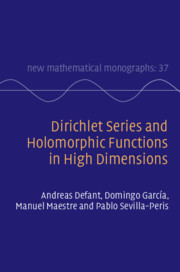Book contents
- Frontmatter
- Contents
- Introduction
- Part 1 Bohr’s Problem and Complex Analysis on Polydiscs
- 1 The Absolute Convergence Problem
- 2 Holomorphic Functions on Polydiscs
- 3 Bohr’s Vision
- 4 Solution to the Problem
- 5 The Fourier Analysis Point of View
- 6 Inequalities I
- 7 Probabilistic Tools I
- 8 Multidimensional Bohr Radii
- 9 Strips under the Microscope
- 10 Monomial Convergence of Holomorphic Functions
- 11 Hardy Spaces of Dirichlet Series
- 12 Bohr’s Problem in Hardy Spaces
- 13 Hardy Spaces and Holomorphy
- Part 2 Advanced Toolbox
- Part 3 Replacing Polydiscs by Other Balls
- Part 4 Vector-Valued Aspects
- References
- Symbol Index
- Subject Index
4 - Solution to the Problem
from Part 1 - Bohr’s Problem and Complex Analysis on Polydiscs
Published online by Cambridge University Press: 19 July 2019
- Frontmatter
- Contents
- Introduction
- Part 1 Bohr’s Problem and Complex Analysis on Polydiscs
- 1 The Absolute Convergence Problem
- 2 Holomorphic Functions on Polydiscs
- 3 Bohr’s Vision
- 4 Solution to the Problem
- 5 The Fourier Analysis Point of View
- 6 Inequalities I
- 7 Probabilistic Tools I
- 8 Multidimensional Bohr Radii
- 9 Strips under the Microscope
- 10 Monomial Convergence of Holomorphic Functions
- 11 Hardy Spaces of Dirichlet Series
- 12 Bohr’s Problem in Hardy Spaces
- 13 Hardy Spaces and Holomorphy
- Part 2 Advanced Toolbox
- Part 3 Replacing Polydiscs by Other Balls
- Part 4 Vector-Valued Aspects
- References
- Symbol Index
- Subject Index
Summary
We give the solution of Bohr’s problem, showing that in fact S=1/2. This is done by considering an analogous problem where only m-homogeneous Dirichlet series are taken into account (defining, then, S^m). Using the isometry between homogeneous Dirichlet series and polynomials, the problem is translated into a problem for these. For each m we produce an m-homogeneous polynomial P such that for every q > (2m)/(m-1) there is a point z in l_q for which the monomial series expansion of P does not converge at z. This shows that, contrary to what happens for finitely many variables, holomorphic functions in infinitely many variables may not be analytic. This also shows that (2m)/(m-1) ≤ S^m for every m and then gives the result. There is more. For each fixed 0 ≤ σ ≤ 1/2 there is a Dirichlet series whose abscissas of uniform and absolute convergence are at distance exactly σ.
Keywords
- Type
- Chapter
- Information
- Publisher: Cambridge University PressPrint publication year: 2019

